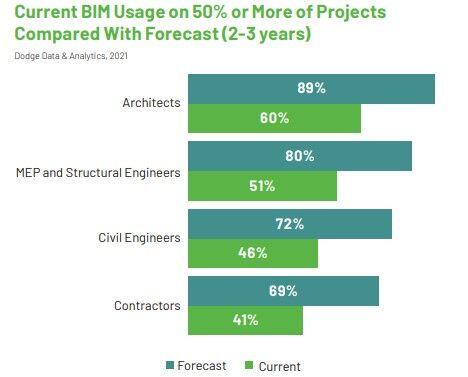
Have you been under the impression that BIM is only applicable to architects? What if we tell you engineers can also use and benefit from BIM adoption in their workflows? Construction projects cannot happen without the skills and knowledge of engineers, and BIM ensures these skills are utilised to the max by providing efficient workflows. So how does BIM positively affect the engineering sector, and what career opportunities does it offer?
What is BIM?
Building Information Modelling, better known as BIM, is a methodological approach to creating, managing and sharing digital built asset data at a multidisciplinary level through all project stages. BIM has been hailed as a paradigm shift in the AEC industry for the immeasurable advantages it offers. It is applicable in every niche in the industry, and complex projects in some fields even necessitate its use. Autodesk reported that by 2026, the percentage of architects and engineers using BIM for over half of their projects is forecasted to reach 89% and 80% respectively. This might come as a surprise as there have been many implementation challenges. It is easy to understand these numbers once you know how BIM is used in engineering projects and why BIM adoption is growing in this sector.
How is BIM Used in Engineering?
 Different stages in an infrastructure project (Source: https://www.autodesk.com/)
Different stages in an infrastructure project (Source: https://www.autodesk.com/)
Catering to a broad field like Engineering, which includes structural, MEP and civil etc, BIM technology must provide appropriate features for each of them. And it does not disappoint. BIM implementation in the engineering field is quite akin to that of architecture since the fundamental principle is the same. However, as engineers design structural and MEP systems in the BIM software, the type of information embedded in them would also differ.
Construction projects, both architectural and infrastructure, are becoming increasingly large and complex. BIM for engineering, including civil engineering, allows managing even the highly complex projects by facilitating team collaboration and sharing knowledge on digital built asset information for seamless integrations and workflows.
Why Should Engineers Use BIM?
 Statistics on current bim use vs forecast (Source: https://www.autodesk.com/)
Statistics on current bim use vs forecast (Source: https://www.autodesk.com/)
It has been a common misconception that engineers cannot use BIM or that it holds no benefits for engineers. BIM offers equally to the engineers the positive values of digitalisation from conceptual to detailed design.
BIM for Civil Engineers
BIM has been gaining interest among civil engineers as a means to improve project outcomes with multiple design solutions and scenarios and ease of management, of the information and other construction professionals, throughout the projects. Their aim for seamless project delivery on time and budget is easily achievable with BIM. For civil engineers working on infrastructure projects, creating visualisations and walk-throughs with AR/VR can also impact the project delivery and how your current and potential clients perceive your ideas, which can also indirectly impact gaining more work or approvals.
Produce an Accurate Site Model
Let us begin with the site. BIM software allows engineers to produce large 3D models of the project site and its surrounding real-world environments, making it a data-rich model. In addition to 2D and reality capture data, the 3D model can now be incorporated with GIS data for better accuracy. An accurate data-rich model is important for the next steps in the construction process - site analysis and detailed infrastructure design.
Achieve Optimal Outcomes
This model is now optimized for subsequent detailed work. We can further utilise this intelligent model to perform analyses and simulations for better-informed design decisions. Flood simulations, roadway configurations, parking space allocation and structural analysis for bridges are the least of what BIM software, such as Infraworks, Revit and Navisworks, can do. Based on the findings, the engineers can offer optimal design solutions.
Mitigate Potential Risks
One prevalent advantage of BIM in any industry is its ability to store information in 3D models. By sharing said information easily across multidisciplinary teams, every stakeholder can understand the project impact and design scenarios better, all the while, preventing any omissions or errors that could turn expensive and cause delays. Site engineers can also predict and mitigate any potential risks and hazards on the construction site, while for architects and other engineers the risk of schedule and budget overruns.
Who is a BIM Engineer?
 BIM models for engineering works (Source: https://www.autodesk.com/)
BIM models for engineering works (Source: https://www.autodesk.com/)
The rise of BIM in the construction industry has created a demand for BIM professionals. This demand means better pay and opportunities and, unsurprisingly, many AEC professionals have also become interested in the new opportunities. If architects can become BIM designers or BIM architects, engineers can potentially become BIM engineers. It is not the only career option! Engineers can also become BIM coordinators, managers and more.
Let’s look at the role of a BIM engineer, a common starting point for most engineers in the BIM industry.
A BIM Engineer’s Responsibilities
In any construction project, several engineers get involved to construct and handle the structural, mechanical and electrical systems required. It is usually simple for houses, but the same cannot be said for large-scale property development and infrastructure projects. BIM engineers combine their expertise in the engineering discipline and their knowledge of BIM to ensure safe and efficient project delivery of the respective systems.
Responsibilities include:
● Design systems using BIM methodology for better coordination in the project team
● Produce documentation, schedules and material take-offs while overseeing the development of the engineering systems.
● Report to BIM coordinators or Managers, who may also delegate extra duties.
● Coordinate with core engineers, who are considered specialists just without BIM knowledge, for inputs on design systems to come up with the most efficient design
● Train BIM modellers to create BIM models for the projects.
Qualification Requirements
To become a BIM engineer, one must have a degree in engineering along with a few years of field experience in the construction industry. As for the academic degree, most professionals who have a few years of experience, and are sure of their career choice, will go on to study Master's degree in Construction Management or equivalent. For freshers in the field, going for BIM courses is a more sensible option to hone their skills in BIM effectively in a shorter period.
BIM Software for Engineers
 BIM model for an underground station part of Crossrail project UK (Source: https://www.crossrail.co.uk/)
BIM model for an underground station part of Crossrail project UK (Source: https://www.crossrail.co.uk/)
And it needs not be mentioned that BIM skills are a must. These skills should not only be limited to modelling as BIM is more than that – it is about documenting and collaborating with other principles. Even for modelling, there are several software a BIM engineer needs to be familiar with.
● Revit : together with its many plugins, Revit is a popular choice for all BIM workflows in every AEC niche.
● Civil 3D : The tools in Civil 3D make it a must-have for civil engineers to design civil infrastructure projects. Learn Civil 3d today!
● Infraworks : This is also another important tool for engineers to generate and evaluate data-rich models
● Navisworks : It allows engineers to review, annotate and even render project models
All these software are part of the Autodesk AEC collection and are also commonly used by BIM engineers.
Are you an engineer planning to start your career in BIM? Novatr welcomes you to join the BIM Professional Course, a 24-weeks online learning programme to master BIM. The course is prepared and delivered by BIM experts with years of experience in the top architectural and BIM firms worldwide. Learn the BIM processes for engineers with popular BIM tools such as Revit, Infraworks and Navisworks.
Interested to learn more about BIM and its career opportunities? Go to our Resources page to find more insights on these topics and more.
Conclusion
BIM has reshaped how engineers work by combining design, data, and collaboration into one connected digital environment. It gives engineering teams the clarity, accuracy, and coordination needed to deliver complex projects faster and with fewer errors. Whether it is structural, MEP, or civil engineering, using BIM tools helps engineers make informed decisions, reduce risks, and improve overall project outcomes.
If you want to build these in-demand skills and become industry-ready, the BIM Professional Course for Civil Engineers offered by Novatr provides hands-on training with the software and workflows used by leading firms. This program helps you move from theory into real project execution with confidence. Visit our resource page to explore more insights, tools, and guides on BIM careers, engineering workflows, and industry knowledge, all with expert-led content.
FAQs
1. How do engineers use BIM in project design and delivery?
Engineers use BIM to develop accurate 3D models, analyze project data, and simulate building performance before construction begins. BIM helps engineers detect clashes, verify structural and MEP layouts, and evaluate design decisions early in the project. It also supports better communication among stakeholders, ensuring that changes are coordinated instantly without confusion. By using BIM tools like Revit, Civil 3D, and Navisworks, engineers can deliver precise designs, track progress, and ensure the final structure meets safety, quality, and performance standards.
2. What are the key benefits of BIM for engineering projects?
BIM offers engineers multiple advantages, including improved design accuracy, faster workflows, and reduced rework. It allows teams to visualize systems in 3D, test performance scenarios, and avoid costly design clashes before construction starts. BIM also supports better coordination, helping structural, MEP, and civil engineering teams work together using shared digital data. This results in smoother decision-making, optimized material use, and fewer delays. Ultimately, BIM enhances quality, reduces risk, and improves overall project outcomes compared to traditional manual approaches.
3. Which engineering disciplines benefit the most from BIM?
While BIM supports the entire AEC ecosystem, structural, civil, and MEP engineering benefit the most. Structural engineers use BIM for load analysis, detailing, and clash-free modeling. Civil engineers rely on BIM to design infrastructure networks, road layouts, and site conditions. MEP engineers leverage it to plan electrical, plumbing, and HVAC systems with precision. Each discipline gains a shared view of project data, reducing mistakes and enabling smarter, more coordinated engineering decisions throughout the construction lifecycle.
4. How does BIM improve coordination between engineers, architects, and construction professionals?
BIM streamlines coordination by enabling all project stakeholders to work on a shared 3D environment. Instead of relying on separate drawings, BIM connects models from architects, engineers, and contractors into one synchronized dataset. This allows everyone to identify issues early, exchange updates instantly, and avoid conflicts during construction. Through tools like Navisworks and Revit, teams can visualize the entire building, review clashes, track changes, and complete tasks more efficiently. The result is greater transparency, fewer delays, and smoother project execution.
Was this content helpful to you










